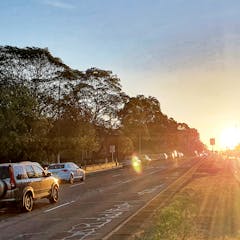
Articles on Liveability
Displaying 1 - 20 of 60 articles

Australia’s big cities have grown rapidly and strains are showing. Yet the state of the urban environment has been rated good and stable due to local and state responses to these challenges.

Two reports — from think tank A New Approach and ex-Grattan Institute director John Daley — say Australian art and culture hasn’t advocated for itself effectively. But we need to try something new.

Cities around the world are reducing traffic speeds and improving access to local services and activities by public transport, cycling and walking. They are now reaping the many ‘slow city’ benefits.

The push for 30km/h speed limits is not about revenue-raising or anti-cars. Even a seemingly small decrease from 40km/h to 30km/h makes a huge difference to the safety and liveability of local streets.

NSW is developing a comprehensive new planning policy with the goal of creating healthy places. A new study finds those people who work as placemakers want these goals embedded in laws and budgets.

The pervasive impacts of infrastructure projects on public health are often overlooked. New research is teasing out the many ways Melbourne’s level-crossing removals will affect people’s health.

If Australia created more age-friendly neighbourhoods — which really are more liveable for everyone — then we wouldn’t have to rely so heavily on underfunded, substandard aged-care homes.

The differences in sentiment in areas of high and low neighbourhood amenity have been clear under Melbourne’s tough COVID restrictions. It’s further evidence of the impacts of inequity on well-being.

Australia lacks a coherent national approach to planning where settlement and growth happens. It’s time to take stock of our cities and regions and work together to improve outcomes across the nation.

Before the pandemic, the country was making great strides towards creating more compact, sustainable and liveable cities.

We are all finding out about neighbourhood liveability as we stay home for the coronavirus lockdown. What we learn about local strengths and weaknesses can help us improve our communities in future.

The neighbourhoods of Paris, Barcelona and Amsterdam with densities 3-5 times those of Melbourne and Sydney offer an insight into how we could transform our cities for the better.

The foundations of orderliness for any city are planning and management. Lagos had this in place in the early days.

The research has been done. The evidence is in. We know how to create cities that are sustainable, liveable and affordable. But we have yet to apply that knowledge widely across Australian cities.

City rankings have become big business – but this expert thinks it’s best to ignore them.

Future Earth Australia is working to create a long-term national plan of transformation for our cities. As part of this, everyone in Australia is invited to have their say in a survey.

The performance of Melbourne and Sydney on this international platform speaks volumes for the position of the country as a study destination.

Australia has well established urban design guidelines, whereas many Chinese cities don’t have any – and it shows. But Australia can also learn from China.

New South Wales now has a minister for public spaces, a nod to their importance to the life of a city. But not all is well with public spaces and some issues demand the minister’s attention.

When a city scores badly on “liveability”, it can put serious pressure on city leaders – but do these rankings really help improve life for local people?
